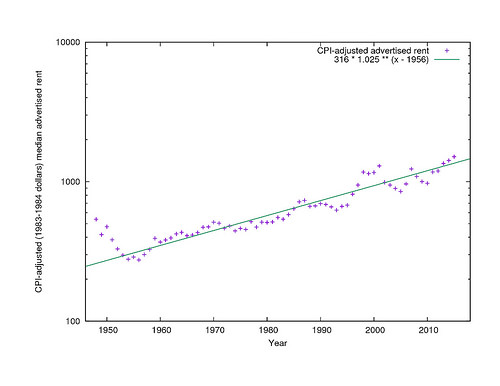Housing prices, SF edition
Eric Fischer set out to look at rental price trends in San Francisco. The standard dataset goes back only to 1979, which was also the start of rent control. Most people would have stopped there. But no:
I set out to replicate the DataBook’s methodology over a wider range of years, … Mostly I used the San Francisco Public Library’s page scans of the newspaper but resorted to microfilm for the few later years where no page scans are available.
That is, he copied down and entered the prices from the ads by hand.
There has been a remarkable constant trend in SF rental prices since the mid-1950s, with median real prices increasing steadily by 2.5%/year, decade after decade.
For the years since 1975, when employment data are available, most of the deviations from this trend can be explained by increases or decreases in numbers of homes in the city, increases or decreases in number of jobs, and increases or decreases in total real salaries and wages paid (specifically salaries and wages, not all income).
Rent control didn’t have a big impact. Speculation didn’t have a big impact — prices were higher during the boom of the 1990s, but only as much as would be expected from more people in the city and the higher salaries and wages they were paid.
San Francisco County already has a population density of over 7000 people per square km — lower than the Auckland CBD, but higher than anywhere else in Auckland. It’s hard for them to increase supply enough to reduce prices, but they might manage to increase supply enough to stabilise prices.
(via Michael Andersen and @BarbsNZgarden)
Thomas Lumley (@tslumley) is Professor of Biostatistics at the University of Auckland. His research interests include semiparametric models, survey sampling, statistical computing, foundations of statistics, and whatever methodological problems his medical collaborators come up with. He also blogs at Biased and Inefficient See all posts by Thomas Lumley »
I stayed with someone in a rent controlled apartment in San Francisco and it definitely made a difference to her life. I would guess that rent controlled apartments don’t turn over as much as non-rent controlled apartments so the statistics are swamped by the latter.
8 years ago
There’s no question it benefits the people who end up in rent-controlled apartments. It’s more a question of how much it hurts other renters and potential renters.
8 years ago
How does it hurt other renters?
8 years ago
Shortage of apartments, higher prices for ones without rent control.
8 years ago
There are higher prices for rentals without price controls but are they really higher than what they would have been had there been no price controls at all?
And I don’t see how there could be any more of a shortage of apartments because of rent control than not. The turnover would be lower presumably but there would be the same amount of apartments in total.
8 years ago